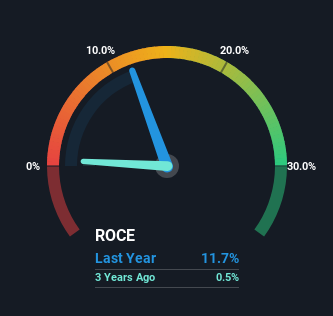- Saudi Arabia
- /
- Trade Distributors
- /
- SASE:1214
Al Hassan Ghazi Ibrahim Shaker (TADAWUL:1214) Is Looking To Continue Growing Its Returns On Capital
Finding a business that has the potential to grow substantially is not easy, but it is possible if we look at a few key financial metrics. Typically, we'll want to notice a trend of growing return on capital employed (ROCE) and alongside that, an expanding base of capital employed. This shows us that it's a compounding machine, able to continually reinvest its earnings back into the business and generate higher returns. So when we looked at Al Hassan Ghazi Ibrahim Shaker (TADAWUL:1214) and its trend of ROCE, we really liked what we saw.
Understanding Return On Capital Employed (ROCE)
For those that aren't sure what ROCE is, it measures the amount of pre-tax profits a company can generate from the capital employed in its business. Analysts use this formula to calculate it for Al Hassan Ghazi Ibrahim Shaker:
Return on Capital Employed = Earnings Before Interest and Tax (EBIT) ÷ (Total Assets - Current Liabilities)
0.12 = ر.س92m ÷ (ر.س1.7b - ر.س889m) (Based on the trailing twelve months to March 2024).
So, Al Hassan Ghazi Ibrahim Shaker has an ROCE of 12%. On its own, that's a standard return, however it's much better than the 7.2% generated by the Trade Distributors industry.
View our latest analysis for Al Hassan Ghazi Ibrahim Shaker

In the above chart we have measured Al Hassan Ghazi Ibrahim Shaker's prior ROCE against its prior performance, but the future is arguably more important. If you're interested, you can view the analysts predictions in our free analyst report for Al Hassan Ghazi Ibrahim Shaker .
How Are Returns Trending?
Al Hassan Ghazi Ibrahim Shaker has broken into the black (profitability) and we're sure it's a sight for sore eyes. The company now earns 12% on its capital, because five years ago it was incurring losses. On top of that, what's interesting is that the amount of capital being employed has remained steady, so the business hasn't needed to put any additional money to work to generate these higher returns. So while we're happy that the business is more efficient, just keep in mind that could mean that going forward the business is lacking areas to invest internally for growth. Because in the end, a business can only get so efficient.
Another thing to note, Al Hassan Ghazi Ibrahim Shaker has a high ratio of current liabilities to total assets of 53%. This can bring about some risks because the company is basically operating with a rather large reliance on its suppliers or other sorts of short-term creditors. Ideally we'd like to see this reduce as that would mean fewer obligations bearing risks.
The Bottom Line
To sum it up, Al Hassan Ghazi Ibrahim Shaker is collecting higher returns from the same amount of capital, and that's impressive. And a remarkable 201% total return over the last five years tells us that investors are expecting more good things to come in the future. Therefore, we think it would be worth your time to check if these trends are going to continue.
Since virtually every company faces some risks, it's worth knowing what they are, and we've spotted 2 warning signs for Al Hassan Ghazi Ibrahim Shaker (of which 1 is significant!) that you should know about.
While Al Hassan Ghazi Ibrahim Shaker isn't earning the highest return, check out this free list of companies that are earning high returns on equity with solid balance sheets.
New: Manage All Your Stock Portfolios in One Place
We've created the ultimate portfolio companion for stock investors, and it's free.
• Connect an unlimited number of Portfolios and see your total in one currency
• Be alerted to new Warning Signs or Risks via email or mobile
• Track the Fair Value of your stocks
Have feedback on this article? Concerned about the content? Get in touch with us directly. Alternatively, email editorial-team (at) simplywallst.com.
This article by Simply Wall St is general in nature. We provide commentary based on historical data and analyst forecasts only using an unbiased methodology and our articles are not intended to be financial advice. It does not constitute a recommendation to buy or sell any stock, and does not take account of your objectives, or your financial situation. We aim to bring you long-term focused analysis driven by fundamental data. Note that our analysis may not factor in the latest price-sensitive company announcements or qualitative material. Simply Wall St has no position in any stocks mentioned.
Have feedback on this article? Concerned about the content? Get in touch with us directly. Alternatively, email editorial-team@simplywallst.com
About SASE:1214
Al Hassan Ghazi Ibrahim Shaker
Engages in the trading, wholesale, and maintenance of spare parts, electronic equipment, household equipment, and air-conditioners in Saudi Arabia.
Proven track record with adequate balance sheet.
Market Insights
Community Narratives


Recently Updated Narratives


MINISO's fair value is projected at 26.69 with an anticipated PE ratio shift of 20x


The Quiet Giant That Became AI’s Power Grid


Nova Ljubljanska Banka d.d will expect a 11.2% revenue boost driving future growth
Popular Narratives


The company that turned a verb into a global necessity and basically runs the modern internet, digital ads, smartphones, maps, and AI.


MicroVision will explode future revenue by 380.37% with a vision towards success



